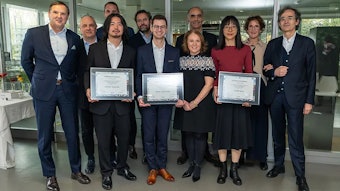Steve Hicks will speak at the World Perfumery Congress (WPC) in Cannes, France, June 1–4, 2010. Read previous interviews with WPC speakers Karyn Khoury and Jack DiMaggio. Advertise in the official post-show report here.
“2010 is a wonderful opportunity to bring true value and excellence to consumers,” says Steve Hicks, P&G’s director of flavor and fragrance development global capability organization. Far from viewing the financial crisis as a threat, Hicks has identified several opportunities for fragrance companies to survive and thrive. He acknowledges that the last 18 months have been tough for the industry, and that a return to profitability and historical growth curves is paramount. And so, he asks, “How does this industry compete in the new world?”
The answer to that question will define those companies still standing in 2020, says Hicks. “It’s a challenging decade to come, but there are wonderful opportunities for innovation and growth.”
1
“Fragrances are still a huge driver of brand selection and loyalty by consumers,” says Hicks. “Nothing has broken our faith in that.” This fundamental truth translates into a focus on launching “superior fragrances to drive brand growth.” As consumers change spending patterns, companies such as P&G are relying on superior fragrances as a driver of innovation. “Fragrances are a delightful experience for consumers, not a chore,” says Hicks. “Across all categories, the commonality is fragrance ‘delight.’ Consumers smile when they talk about fragrances. It is truly an element of happiness.” In response, he says, fragrance industry leaders have engaged in new levels of innovation and reinvention. “I would be very fearful if they weren’t,” he adds, noting that the industry must outmaneuver the specter of commoditization.
2
The economic downturn is forcing the industry to rethink the fine fragrance business model—for the better. "There has been an industry acceleration in the launch of new fine fragrance brands and extensions [in recent years]," says Hicks. "We have confused the consumer, and the industry has become addicted to the increasing pace of the new initiatives.” The result is that many new fine fragrances vanish in 18 or 24 months. The industry, says Hicks, is “not creating a lot of permanence. We need a few more classics, things that will stand the test of time.” Recent struggles in the category as a result of the financial crisis have shifted the focus from “more-and-more” to “fewer, bigger and better”, he says, which in the long run will be a plus for the industry.
3
Innovation is the lifeblood of fragrance, providing continued differentiation. “It’s the most important thing to ensure survival,” says Hicks. “The worst thing you can do is start cutting back on innovation machinery and lose differentiation.” Thus, he says, now is an ideal time to pursue such differentiation in a bid to “survive, grow and thrive.”
“I see some of the major industry players investing more in R&D,” he says, calling it a “brave and strategic stroke to take in tough times.” Proprietary innovation—captive fragrance materials in particular—are a keystone of this strategy. While there are perhaps 6,000 chemicals available to fragrance houses, he says, it is a mistake to think everything has been invented. While captives create differentiation, they also combat commoditization of ingredients and finished fragrances.
In addition, says Hicks, the industry may well lose some materials to the REACH process. The opportunities for replacers of lost aroma chemicals are obvious.And, he says, new chemistry can bring new and different fragrance experiences to consumers by boosting tenacity or allowing performance under difficult conditions.
4
Hicks sees the consolidation of fragrance industry organizations around IFRA as a positive move, creating “critical mass” around global issues and effecting more legislative influence and better PR around fragrance. “The fragrance industry is not at the end of the food chain," he notes. "Small changes in fragrance policies have huge effects on downstream users." Thus, it is difficult for the industry to make autonomous changes, making it crucial to be more connected within its niche and to customer organizations such as the Personal Care Products Council and Soap and Detergent Association.
This synergistic industry structure is particularly crucial as NGOs have made significant moves on the issue of fragrance ingredient labeling. These NGOs generally seek complete ingredient transparency through labeling on consumer products, he notes, including perfumes. “The true intellectual property is the formula of the perfume itself,” says Hicks. “Publicly exposing that will not make anyone safer, will not teach [consumers] anything, and will destroy intellectual property.” For this reason, he says, the industry must engage the public image of fragrances in a coordinated manner. NGOs, he notes, aren’t speaking to industry, but rather are trying to scare the public. “Attacking everyday, trusted brands creates scandal and mistrust, and that makes a good story,” says Hicks. When the public is alarmed, legislators respond. “The industry needs to give the public a positive story.” Here Hicks points to a recent successful American Chemistry Council advertising campaign that highlighted chemistry’s positive contributions to consumers’ lives.
5
Globalization and developing markets continue to provide new opportunities for fragrance houses and their customers. P&G, says Hicks, is “global, and becoming more global.” Growth in developing markets is accelerating, led by China, India, Latin America and, in the not too distant future, continental Africa. Fragrance houses, says Hicks, are “helping us light that fire.” To succeed in these emerging markets, he notes, companies cannot merely relaunch successful Western scents. Often the cost and aesthetic taste targets will not align. Instead, he says, innovation and low-cost platforms need to be mastered to launch successes into new markets.
6
Hicks is pleased that the major industry players are taking responsibility for protecting the important fragrance molecules through the REACH process, particularly concerning the generation of new safety data on common ingredients. While there may be some “surprises” along the way, necessitating some reformulations, Hicks believes the industry is now moving smoothly to organize, study and register key materials—it is no longer playing catch up.
Importance of WPC 2010
“WPC represents the opportunity to network across the globe in a tight-knit industry,” says Hicks. “It’s very healthy to have this closeness. The networking is the glue—new connections, seeing old friends, side conversations that lead to new business opportunities.” Though he travels throughout the year, Hicks says, WPC provides a unique opportunity to encounter more than just bits and pieces of the industry. “It’s the single best networking opportunity in this industry,” he concludes.










